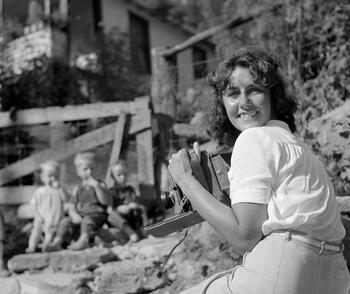Colorado captured by Marion Post Wolcott
Blizzard near the Aspen Post Office photo Marion Post Wolcott.
By Rob Carrigan, robcarrigan1@gmail.com
Marion Post Wolcott's most famous photos in Colorado feature the Denver Stockyards, the Aspen Post Office in full blizzard, and somewhat forgotten mining towns of Ashcroft, Montezuma, Meredith, and other ghosts. Wolcott was an American photographer who worked for the Farm Security Administration during the Great Depression, documenting poverty, the Jim Crow South, and deprivation.
"Back in the late 1930s and early 1940s, when it was still relatively novel to use photographs in the press to inform and influence public opinion and policy, Marion Post Wolcott captured images of life in rural America to galvanize support for the New Deal. She was hired as a photographer for the Farm Security Administration (FSA), a federal agency dedicated to improving the lives of America’s most impoverished farmers. Her images vividly exposed the social and economic conditions wrought by the Great Depression and Dust Bowl, and included tenant farmers, migrant workers, cotton pickers, among others, all living in poverty and racially divided communities," wrote Carey Moncaster, MA, for SPICE, Stanford Program on International and Cross-Cultural Education. She is also the granddaughter of Marion Post Wolcott. SPICE features a selection of Marion Post Wolcott’s photographs in an ongoing series along with organizing questions for educators.
The Farm Security Administration (FSA) was a New Deal agency created in
1937 to combat rural poverty during the Great Depression in the United
States. It succeeded the Resettlement Administration (1935–1937).
The
FSA is famous for its small but highly influential photography program,
1935–44, that portrayed the challenges of rural poverty. The
photographs in the FSA/Office of War Information Photograph Collection
form an extensive pictorial record of American life between 1935 and
1944. This U.S. government photography project was headed for most of
its existence by Roy Stryker, who guided the effort in a succession of
government agencies: the Resettlement Administration (1935–1937), the
Farm Security Administration (1937–1942), and the Office of War
Information (1942–1944). The collection also includes photographs
acquired from other governmental and nongovernmental sources, including
the News Bureau at the Offices of Emergency Management (OEM), various
branches of the military, and industrial corporations.
In the early 1940s and late 1930s, Marion Post Wolcott, shooting photos for the eventually famous collection of Farm Security Administration/Office of War Information Black-And-White Negatives, including capturing the ghost mining town of Ashcroft, Colorado, and other Western Slope locations and mining towns such as Leadville, Montezuma, and Denver.
Denver stockyards by Marion Post Wolcott.
"Only the second woman hired on the project, Marion traveled backroads
for weeks on end alone—a brave and determined assignment for a young,
white woman at that time. She was influenced early by a traveling mother
who pioneered birth control clinics with Margaret Sanger and a loving
relationship with her Black caregiver, and was later exposed to
progressive ideas, art, and education in New York City and Austria as
Hitler rose to power. These experiences helped Marion view inequity and
injustice through the lens of race, class, and gender, and her interest
in photography deepened as a way to illuminate complex issues and
influence social change," Moncaster says.

"At the height of her photographic career, Marion’s professional life
suddenly ended in 1942, after she met her husband Lee Wolcott, an
assistant to Secretary of Agriculture Henry Wallace and recent widower
with two young children. Amid the frenzy of McCarthyism, the Wolcotts
opted to leave D.C. and try their hand at farming. Marion put down her
camera to focus on the demanding roles of farm wife and mother to her
growing family," Moncaster says in information about SPICE's presentation of her work.
"Years later, leaving the farm for her husband’s USAID posts in Iran, Egypt, Pakistan, and India, Marion picked up her camera again to capture social and political images. Upon retirement back in the United States, she continued photographing people and activities of personal interest such as anti-war protests and other social movements. Some of these images have been included in exhibits and media as FSA photographs became increasingly featured in present-day discussions. Her FSA film negatives remain archived in the U.S. Library of Congress and her prints are included in major collections including the Metropolitan Museum of Art and Smithsonian Institute."
Despite late recognition, Wolcott often reflected on and grappled with the hard choices women of her generation faced as they tried to balance raising a family with a professional career, says her granddaughter.
A few years before her death in 1990, as a keynote speaker at a Women in Photography Conference, Marion said to her audience:












No comments:
Post a Comment